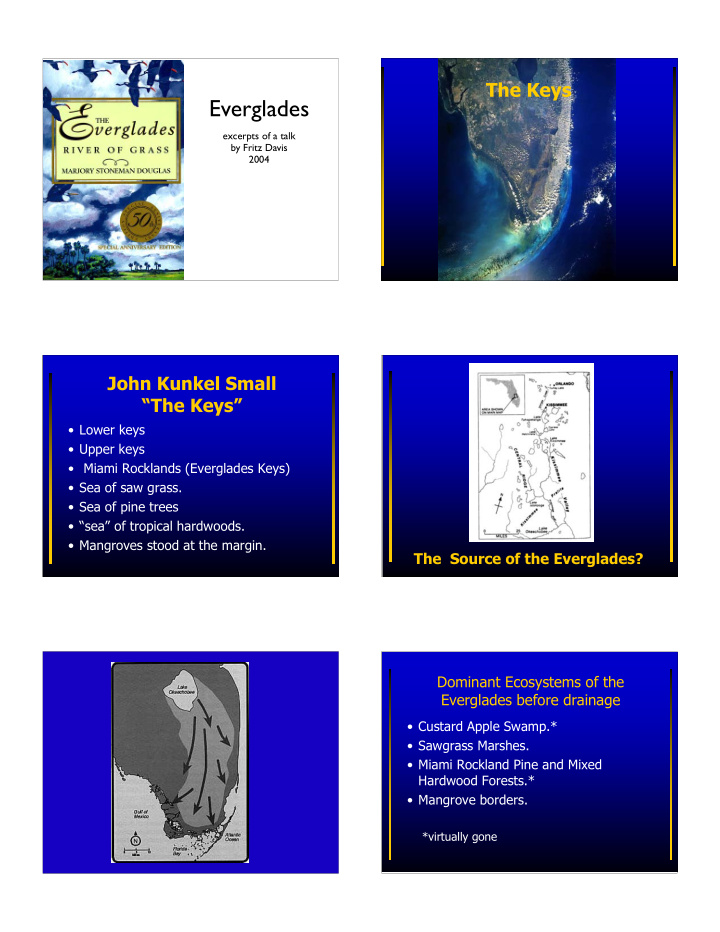



The Keys Everglades excerpts of a talk by Fritz Davis 2004 John Kunkel Small “The Keys” • Lower keys • Upper keys • Miami Rocklands (Everglades Keys) • Sea of saw grass. • Sea of pine trees • “sea” of tropical hardwoods. • Mangroves stood at the margin. The Source of the Everglades? Dominant Ecosystems of the Everglades before drainage • Custard Apple Swamp.* • Sawgrass Marshes. • Miami Rockland Pine and Mixed Hardwood Forests.* • Mangrove borders. *virtually gone
Custard Apple Swamp Custard Apple Swamp • Reminded explorers of cathedrals. – Gourd vines, giant ferns, and beautiful epiphytes. • Uninhabitable for Europeans. • Indians promoted the growth of the custard apple swamp. Custard Apple Swamp After Clearing Sawgrass • Another virtually impenetrable barrier • Travel slowed to as little as a mile and a half per day. • Healthful place?
Sawgrass Detail Sawgrass Cladium jamaicense The River of Grass Pine Forest covered 90% of the Miami rocklands. • The transverse glades. • Banana Holes • Logged (low quality pine). • Hardwood hammocks. Red Mangrove Pinewoods ( Rhizophera mangle ) • Dense stands. • Unique prop root system = exotic and challenging landscape. • “Walk” by sending out roots. • Only plume hunters visited. – Breeding sites for marine animals and wading birds.
Red Mangroves Red Mangroves Reclamation of the Buckingham Smith Everglades • For Progressives: a worthy challenge. • 1847: First drainage reconnaissance of the Everglades: $300,000 to $500,000. • “Reclamation:” – Florida’s first senator J.D. Westcott: – “Reclaim:” sounds worthy “health hazard from dying fish and – Actual meaning: drainage and conversion vegetation.” to farmland. • Swamp Lands Act of 1850 • Internal Improvement Fund (IIF) – “reclamation.” 1881 Canals • Governor William D. Bloxham arranged • Richard J. Bolles (December 23, 1908). to sell Hamilton Disston 4 million acres • $1 million for 500,000 acres of of Florida land for $1 million. Everglades land. • Disston could claim half of the land he • Trustees agreed to spend $1.50 of drained and “reclaimed.” each $2.00 per acre on 5 canals. – Dug a canal from the Caloosahatchee River to Lake Okeechobee.
Bureau of Irrigation and Drainage Planned Canals Investigations Engineering (Wright) Report • 8 canals from Lake Okeechobee through the Everglades • Reclaim roughly 1,850,000 acres (one dollar per acre). Land Rush Florida Fruit Lands Company • Three companies sold • 8,000 farms - 10 acres • 3,620 - 20 acres – 4,000 10-acre farm • 40 - 250 acres – $20 to $200 per acre. • 20 - 160 acres • 8 - 320 acres • 2 - 640 acres. • 10,000 10-acre farms, sight unseen. Easy Living? More Problems “Take a tent, a bag of beans, and a hoe; • Muck dried and formed dust storms. clear a few row in the saw grass, plant • Land was not as fertile as the farmers the seed, and in 8 weeks you will have imagined � Cattle died. an income.” – Lack of trace metals in the soils. – Custard apple and elder: machetes. – Pull up the smaller brush and to cut the larger roots • One week to clear an acre.
Flood Control? Cold Weather • 1913 – 1927: 13 major control 1914 structures (>$1.8 million). • Frost every two weeks between • 1926 Hurricane passed over Lake. November and April – Dike burst and the town of Moore Haven • Damaged fragile truck crops. suffered severe flooding. Moore Haven Areas of Damage Hoover Levee Army of Corps of Engineers • 4 recommendations regarding Lake Okeechobee. – Increase the depth of the Caloosahatchee River – Expand the St. Lucie Canal (the existing control structure). – Dredge the channel of Taylor Creek to control flooding in Okeechobee. – Build a much larger levee along the south shore of the Lake.
Hoover Dike Dredge Unintended Consequences Everglades Agro Area • wildfires 1950s EAA supported • soil loss • Winter vegetables • saltwater intrusion into freshwater • sugar cane wells • cattle After 1961: sugar – Cuban tension / government subsidies. Central and Southern Florida Flood Control District • Established by Congress after 1947 floods. • Army Corps of Engineers: 1600 miles of canals, levees, and spillways – agricultural area – 3 water conservation areas – 2 national parks – Straightened the Kissimee River • Guaranteed an overland water supply for southern Miami-Dade County. Sugar Cane
South Florida Water Everglades National Park Management District • Also in 1947. • Controls • Harry Truman dedicated 1.3 million – quantity, acres. – quality, – distribution, • Ended 4 decades of squabbling at the – timing local, state, and federal levels. • of water release into the Everglades. Everglades Today The Comprehensive Everglades Restoration Plan • Re-establish a more natural flow of water throughout South Florida. – Including The Everglades • Ensure reliable water supplies and provide flood control. $8 Billion and 50 Years • More than 240 miles of canals and levees will be removed. – Most of the Miami Canal and the levee that separates the Big Cypress National Preserve from the Everglades National Park. • 20 miles of Tamiami Trail (Route 41) will be rebuilt on a bridge to allow a freer flow of water into the Everglades National Park. • Water will be captured and stored in new reservoirs, man-made wetlands and underground wells. Everglades Restoration
Recommend
More recommend